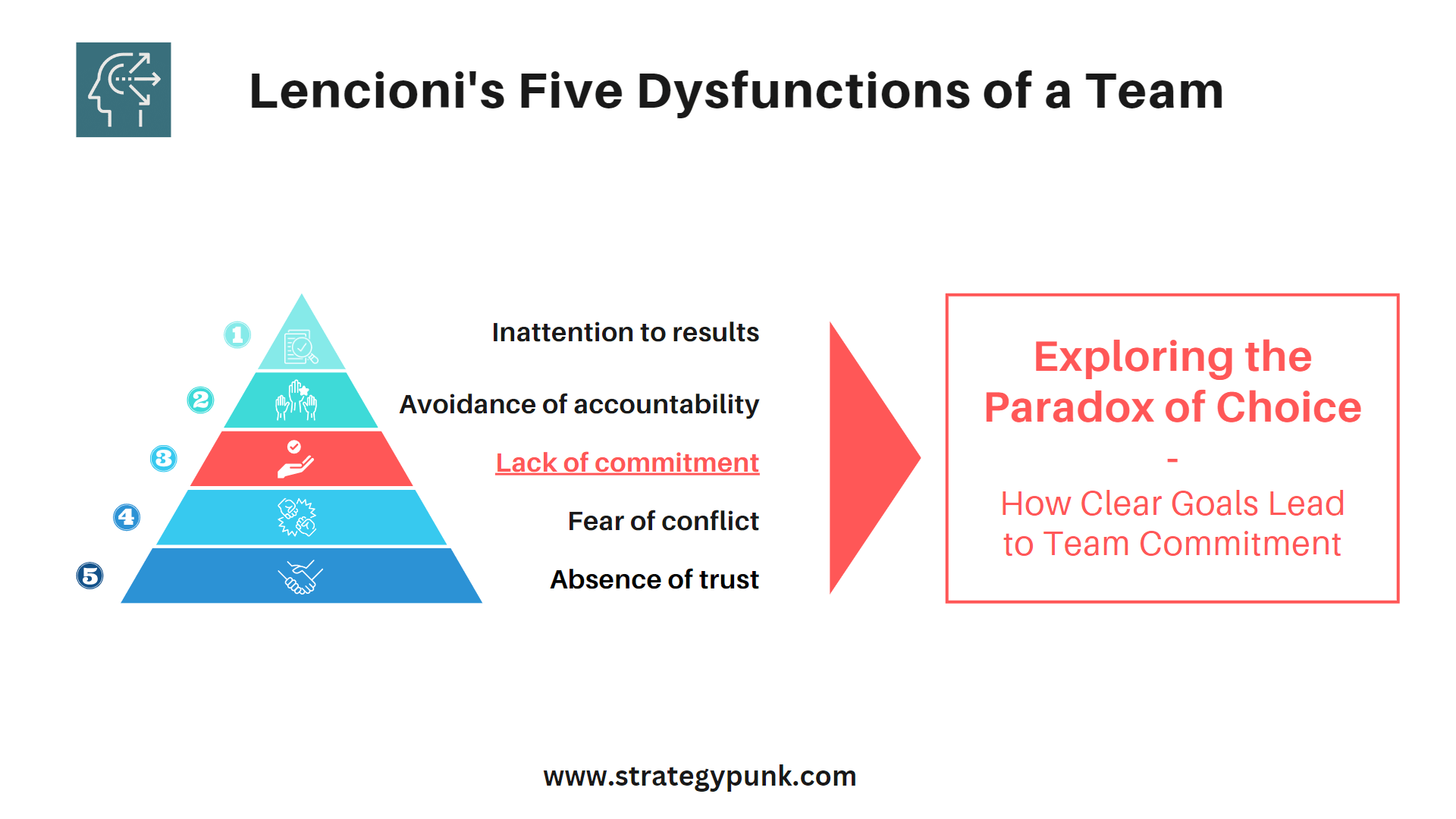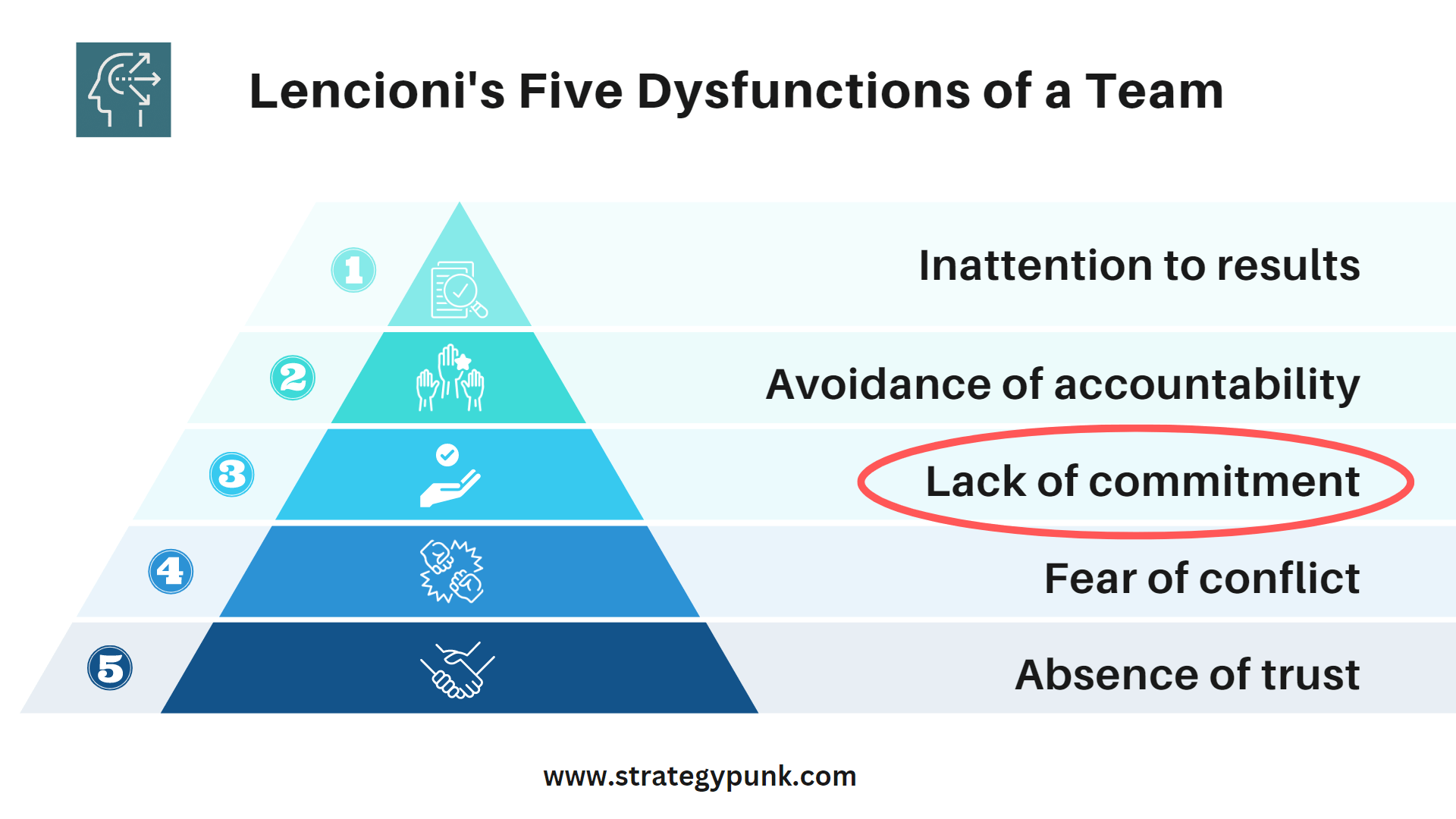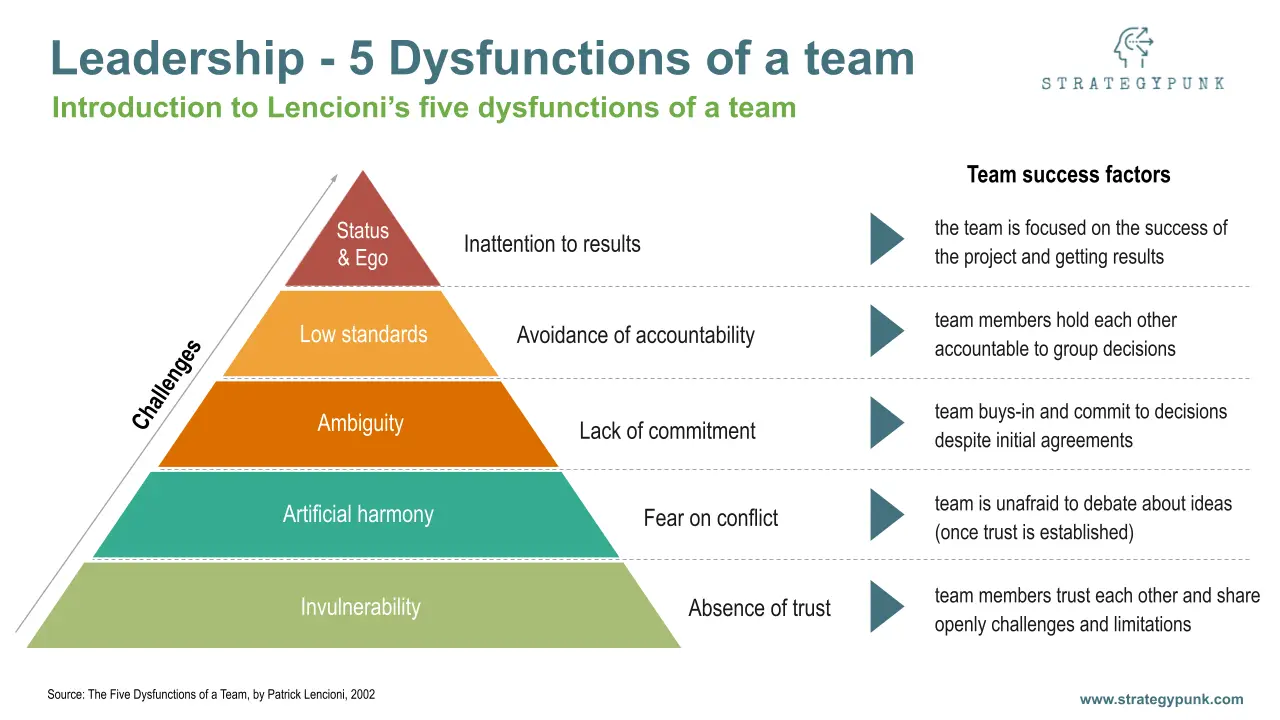Exploring the Paradox of Choice: How Clear Goals Lead to Team Commitment
Explore Lencioni's Five Dysfunctions of a Team and how lack of commitment impacts team success. Unleash the power of clear goals to combat the paradox of choice in our blog post.

Introduction
If you're a team leader, you know that one of the most challenging aspects of managing a group is getting everyone on the same page. You want your team to be committed to the goals and strategies you've set, but sometimes, it can feel like you're fighting an uphill battle. This is where the paradox of choice comes in - the more options people have, the harder it is for them to decide and commit to a particular course of action.
But what if we told you there's a way to use the paradox of choice to your advantage? You can increase your team's commitment and motivation by providing clear goals and strategies. When people clearly understand what they're working towards and how they will get there, they're more likely to be invested in the process and see it through to the end. In this article, we'll explore the paradox of choice and how it relates to team commitment, as well as strategies and perspectives you can use to help your team make decisions and stay focused on their goals.
Lencioni's Five Dysfunctions of a Team and the Lack of Commitment
When building a successful team, many factors can come into play. One of the critical components is commitment.

Without a strong commitment, a team can quickly fall apart and fail to achieve its goals. Lencioni's Five Dysfunctions of a Team is a framework that can help teams identify and overcome barriers to commitment.
The Five Dysfunctions of a Team are:
- Absence of Trust: When team members are not open and honest with each other, it can create a lack of trust that can be difficult to overcome.
- Fear of Conflict: Conflict can be healthy for a team, but when team members are afraid to engage in conflict, it can lead to a lack of commitment.
- Lack of Commitment: When team members are not committed to their goals, it can lead to a lack of motivation and drive.
- Avoidance of Accountability: Team members must hold each other accountable to avoid creating a lack of responsibility and ownership.
- Inattention to Results: When team members are not focused on achieving their goals, it can lead to a lack of progress and success.
Of these five dysfunctions, lack of commitment is critical, and team members must be committed to the team's goals to succeed. This lack of responsibility can be caused by various factors, including clarity about the team's goals and objectives.
Establishing clear goals and objectives for the team to overcome this lack of commitment is vital. This can help team members understand what they are working towards and why it is essential. Additionally, it is crucial to create a sense of ownership and accountability among team members. When team members feel a sense of ownership over their work, they are more likely to be committed to its success.
For more information on Lencioni's Five Dysfunctions of a Team, check out our blog post or download our free PowerPoint template to help you facilitate team discussions around these important topics.

Defining the Paradox of Choice
When it comes to making decisions, having many options can be overwhelming. The more options you have, the harder it can be to choose. This is known as the paradox of choice.
The paradox of choice refers to the idea that while having many options may seem desirable, it can lead to indecision, anxiety, and dissatisfaction. When faced with too many choices, people may struggle to make a decision, or they may second-guess the choice they do make.
The Psychology of Decision-Making
The paradox of choice is rooted in the psychology of decision-making. When faced with many options, our brains must work harder to evaluate each one and determine the best choice, which can lead to decision fatigue, making it even harder to decide.
Moreover, having too many options can lead to a fear of missing out (FOMO). When you have many choices, it's easy to imagine all the other possibilities you're not choosing and wonder if you're making the right decision.
On the other hand, having clear goals can help to alleviate the paradox of choice. When you know what you want to achieve, you can more easily evaluate options and decide to align with your goals.
In a team setting, having clear goals can also foster commitment. When everyone knows what they're working towards, they can more easily work together towards that common goal. This helps build trust and collaboration within the team.
In the next section, we'll explore some specific paradoxes that can arise when making decisions in a team setting.
Exploring the Paradox of Choice in Leadership
As a leader, you face the paradox of choice every day. It would help if you made decisions that balance exploration and exploitation, short-term and long-term goals, and individual and team needs. This paradox can lead to indecision, stress, and burnout. However, managing it effectively can lead to team commitment, innovation, and growth.
Paradoxical Leadership Strategies
Paradoxical leadership strategies involve embracing contradictions and finding ways to balance them. For example, you can encourage your team to explore new ideas while exploiting existing strengths. You can set clear goals while also allowing for flexibility and creativity. You can provide structure while also empowering your team to make decisions.
The Power of Belonging
Belonging is a powerful motivator for team commitment. When team members feel they belong, they are more likely to work together, support each other, and stay committed to the team's goals. As a leader, you can foster belonging by creating a positive team culture, providing opportunities for team bonding, and recognizing and rewarding team members' contributions.
Innovation and the Paradox of Choice
Innovation requires exploring new ideas and taking risks. However, too much choice can lead to decision paralysis and missed opportunities. As a leader, you can balance the paradox of choice by setting clear goals and priorities, providing guidance and support, and encouraging experimentation and learning.
Dysfunctions of a Team
The dysfunctions of a team can also contribute to the paradox of choice. For example, team members may hesitate to share ideas or take risks when they don't trust each other. When there is a lack of accountability, team members may not feel committed to the team's goals. As a leader, you can address these dysfunctions by building trust, setting clear expectations, and holding team members accountable.
In conclusion, exploring the paradox of choice in leadership requires embracing contradictions, fostering belonging, balancing innovation and will, and addressing the dysfunctions of a team. By managing this paradox effectively, you can lead your team to more significant commitment, innovation, and success.
The Role of Conflict in the Paradox of Choice
When managing a team, it's not uncommon to experience conflicts. These conflicts can arise from various sources, including differences in opinions, values, and goals. However, it's essential to understand that competition can play a positive role in the paradox of choice.
Managing Paradoxical Tensions
Paradoxical tensions refer to the inherent contradictions that arise when trying to achieve multiple goals simultaneously. In the context of team management, this can manifest as a conflict between the team's overarching vision and the team members' individual goals.
One approach to managing these paradoxical tensions is to embrace them. Rather than trying to eliminate the stress, you can use it to your advantage by encouraging team members to explore and understand the different perspectives and goals within the team. This can lead to a more nuanced understanding of the team's goals and a more significant commitment from team members.
Another approach is to actively manage the tension by setting clear goals and expectations for the team while allowing flexibility and adaptability. This can help reduce the potential for conflict while still allowing for exploring different perspectives and goals.
Dysfunctional Teams
Of course, not all conflicts are productive. In dysfunctional teams, disputes can arise from a lack of trust, poor communication, or an unwillingness to compromise. In these cases, addressing the underlying issues causing the conflicts is essential rather than simply trying to manage the tension.
This may involve implementing team-building activities or addressing individual performance issues. It may also require a more fundamental shift in the team's culture or structure. Whatever the approach, it's essential to prioritize the team's health and well-being and work towards creating a positive and productive working environment.
In conclusion, conflict can play a positive role in the paradox of choice as long as it is managed effectively. By embracing paradoxical tensions and setting clear goals and expectations, you can encourage team members to explore different perspectives and goals, leading to a greater sense of commitment and cohesion within the team. However, it's important to address underlying issues causing conflicts and prioritize the team's health and well-being.
Organizing and Performing with Clear Goals
When exploring the paradox of choice, one of the most important things you can do is to organize and perform with clear goals. This means that you need to have a clear understanding of what you want to achieve, and you need to communicate that understanding to your team.
Frameworks for Managing Paradoxes
One of the best ways to manage paradoxes is to use frameworks that help you to understand and navigate them. There are many different frameworks that you can use, but some of the most popular ones include the Cynefin framework, the Stacey matrix, and the OODA loop.
The Cynefin framework is beneficial for managing complex systems. It helps you understand the different types of problems you might encounter and guides you in approaching each type of problem.
The Stacey matrix is a tool that helps you understand your certainty level about a project. It allows you to identify the different types of tasks you might encounter and guides you on approaching each type of project.
The OODA loop is a decision-making tool that helps you to make decisions quickly and effectively. It stands for Observe, Orient, Decide, and Act and can be used in various situations.
Learning and Change Management
Learning and change management are also critical when exploring the paradox of choice. You need to be able to learn from your experiences, and you need to be able to adapt to changing circumstances.
One of the best ways to learn is to use a process called the Plan-Do-Check-Act cycle. This process involves planning what you want to do, doing it, checking the results, and then making changes based on what you have learned.
Change management is also essential because it helps you to manage the transition from one state to another. You need to be able to communicate the changes that you are making, and you need to be able to manage the resistance that you might encounter.
In conclusion, organizing and performing with clear goals is essential when exploring the paradox of choice. By using frameworks for managing paradoxes and focusing on learning and change management, you can achieve your goals and build a committed team.
The Importance of Goal Clarity in Team Commitment
Clear goals are an essential component of team commitment. When team members understand the goals and objectives they are working towards, they are more likely to be committed to achieving them. This section explores the importance of goal clarity in team commitment, including the paradox of control.
The Paradox of Control
The paradox of control refers to the idea that too much power can lead to less commitment. When team members feel they are being micromanaged or their autonomy is being taken away, they may become less committed to the team's goals. On the other hand, when team members feel like they have control over their work and are trusted to make decisions, they are more likely to be committed to the team's goals.
Finding a balance between control and autonomy is essential to avoid the paradox of power. As a team leader, you should provide clear goals and expectations and allow team members to make decisions and take ownership of their work. This helps build trust and increase team commitment.
Contradictions
Clear goals can also avoid contradictions within the team. When team members clearly understand the goals and objectives they are working towards, they are less likely to work against each other or pursue conflicting dreams. This helps build a strong sense of teamwork and increases team commitment.
To avoid contradictions, it is essential to communicate clearly and regularly with team members. Make sure that everyone is on the same page and understands the goals and objectives of the team. Encourage open communication and collaboration to help avoid conflicts and contradictions.
Control
Finally, clear goals can give team members a sense of control over their work. When team members understand the goals and objectives they are working towards, they are more likely to feel like they have control over their work and are making a meaningful contribution to the team. This can increase motivation and team commitment.
To give team members a sense of control:
- Ensure goals are clearly defined and measurable.
- Provide regular feedback and recognition to help team members feel they are progressing toward their goals.
- Encourage team members to take ownership of their work and make decisions to help achieve the team's objectives.
In summary, clear goals are essential for team commitment, and they help to avoid contradictions and give team members a sense of control over their work. By balancing power and autonomy, communicating clearly and regularly, and encouraging collaboration and open communication, you can help build a strong sense of teamwork and increase team commitment.
Conclusion
In conclusion, having clear goals is crucial for team commitment. Without clear goals, team members may lack direction and feel unmotivated, resulting in a lack of commitment. This lack of responsibility can lead to poor team performance and failure to achieve desired outcomes.
As discussed earlier, Lencioni's Five Dysfunctions of a Team can hinder team commitment, and one of the critical dysfunctions is a need for more clarity around goals. Therefore, it is essential to ensure that team goals are well-defined, communicated clearly, and understood by all team members.
Additionally, it is crucial to create an environment where team members feel comfortable expressing their opinions and ideas. This open communication can lead to a better understanding of team goals and a more committed team.
It is also important to note that having too many goals can be counterproductive. When faced with too many options, team members may experience decision paralysis, leading to a lack of commitment. Therefore, it is essential to prioritize goals and focus on the most critical objectives.
Having clear goals is a fundamental aspect of team commitment and performance. By ensuring that team members understand and are committed to the goals, teams can achieve their desired outcomes and reach their full potential.







